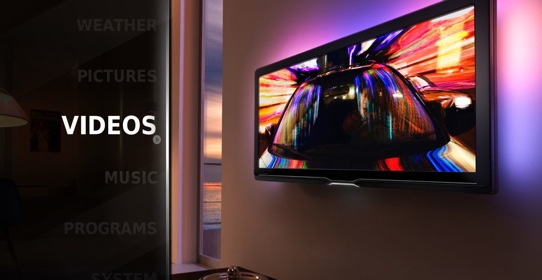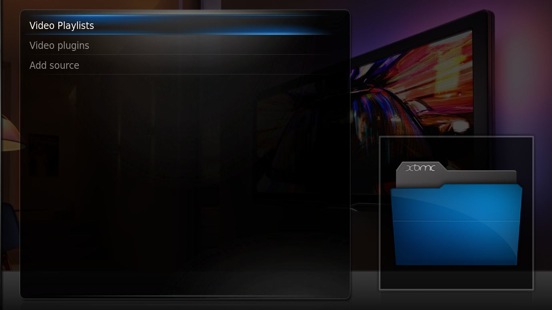Quick start guide
Welcome to XBMC!
Congratulations new users to your choice in media center software: XBMC. The XBMC interface is designed with the 'Home Theater' in mind. This means it is best viewed on a large-screen TV while you sit on your couch 10-feet away from that TV, rather than on a small monitor while you sit at your desk. And, because everything is designed with the home theater experience in mind, the best way to interact with XBMC is with a remote control, rather than a computer mouse. If it helps, you can think of XBMC as the ultimate DVD-Player/Set-top-box, rather than just another program on your computer, (and NO ONE uses a mouse with a DVD-Player/Set-top-box).
First Steps
XBMC Main Features
XBMC does two things really well. It can play your music and videos, and it can display all of your music and videos in something we call the "library". In fact, if you have ever read anything about XBMC before, then you have probably already seen pictures or videos of the Music and Video Library in action.
Getting ready to play music and videos
To play Music, a TV show Episode, or a Movie, you first have to tell XBMC where your media is located.
Letting XBMC know where to find your videos and music is very simple. First, open XBMC, then just click up or down in the home menu until either "Videos" or "Music" is highlighted. For the rest of the explanation in this guide we will use "Videos" (and, specifically "Movies") as the example, but it works the same way in Music, (as well as for TV shows and Music Videos).
Adding a Video Source
Click "Videos" in the home screen menu, for this example we are going to use the Confluence skin, which is the default skin in XBMC since version 9.11 (a.k.a. "Camelot").
Now click "Add Source".
The "Add Video Source" screen will be displayed.
Click on "Browse" button. The following screen will be displayed.
Now browse to where you keep your videos stored. If you keep them shared on a network drive, read the Configuring PC Shares article for more information about setting up a share on your computer first. If you have already done that then all you need to do is to scroll down the list until the "Windows Network (SMB)" choice is highlighted and click that option, and then browse through your network shares.
Once you have found the folder you keep your videos in, click the "OK" button.
NOTE! When you begin using the library, you will find that it is a really good idea to keep your "Movie" folder and your "TV Shows" folder and files stored separately from each other, so keep that in mind.
Now name this Video Source however you like. If it is a movie folder, you will probably want to name it "Movies", and if it is a TV Show folder then you will probably want name it TV Shows, at least if you are using the English language in the XBMC interface. The name for the Video Source is totally up to you. For this example, since we are dealing with movies, we just named it "Movies".
Next, you have to tell XBMC what type of content is inside of the folder you just added, so click the button "Set Content".
Setting Content
This section is why keeping your TV Shows and Movies separate is important. When you click set content, you can set your video content as Music Videos, Movies, or TV Shows. Scroll through the options until you get to the correct one. Because in our example we're adding Movies, we will scroll to "Movies" and go through the Movie Settings.
Setting Movie Content Options
If you keep each of your movies in its own folder with the movie name in it, like this:
C:\Movies\Big Buck Bunny\Big Buck Bunny.avi
Then you want to tick the "Use folder names for lookups" option.
If you however keep all your movies in one big folder, like this:
C:\Movies\Big Buck Bunny.avi
C:\Movies\Big Buck Bunny II: Rise of the Lepus.avi
Then leave all options unticked.
If your movies are ripped DVD-Video files using a "VIDEO_TS" folder structure, like this:
C:\Movies\Big Buck Bunny\VIDEO_TS\VIDEO_TS.IFO
C:\Movies\Big Buck Bunny\VIDEO_TS\VIDEO_TS.VOB
Then you want to tick the "Scan Recursively" option.
Run Automated Scan
Finally, since this is your first time adding adding media files to XBMC, we may as well take care of everything right now, so let us go ahead and create that pretty looking Library.
To do so, tick the "Run 'Automated Scan" option.
Now, click "OK" and then "OK" again. XBMC will now begin to scan your folders. Depending on how many movies you have in the folder you selected, this scan could take a long time since it will be connecting to the internet and collecting metadata and artwork for all of the selected items. When it is finished, your library will have been created, but you will not be redirected to it automatically, see the "Turning on the Library" section below to go to your library.
Turning on the Library
Assuming you are using the default skin, Confluence, from the videos screen, to turn on the Library, just click left once to pull up the Side Menu. Then scroll down and click "Library Mode".
And that is it, you are now done. You now have a beautiful Library full of all your great movies, complete with titles, fanart, and tons of metadata information.
Now that you have followed the guide above you should be able to figure out how to put your TV Shows and Music into the Library. To do so, simply follow this guide again (but, of course, select choices appropriate to your goal. For example, select "Music" if you want to add music).
Important note about the Context Menu
As you read this wiki and experiment on your own, you will quickly learn about the value of the Context Menu.
To use it, while highlighting an item, press the "C" key on the keyboard. If you are using a mouse, you can right click while hovering over an item. With remote controls, the option to bring up the Context Menu differs based on the remote control that you use.
The important point is that the "Context Menu" is really the key to controlling XBMC. With it you can queue an item, play it, set content, update the library, scan for new media, and so on.
Conclusion
Thanks for reading this Quick Start Guide. Below in the "Also see" section you will find additional suggested reading that may be useful for getting started with adding your media files to XBMC. We have done our best to answer every question in this wiki, the XBMC Online Manual and the Frequently Asked Questions, however if you still can not find your answer after extensively searching, feel free to ask, see XBMC:Community Portal.


